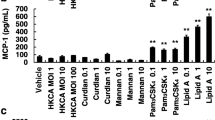Abstract
Candida albicans was found to be highly susceptible to inhibition and inactivation by lactoferricin B, a peptide produced by enzymatic cleavage of bovine lactoferrin. Effective concentrations of the peptide varied within the range of 18 to 150 μg/ml depending on the strain and the culture medium used. Its effect was lethal, causing a rapid loss of colony-forming capability. 14C-labeled lactoferricin B bound to C. albicans and the rate of binding appeared to be consistent with the rate of killing induced by the peptide. The extent of binding was diminished in the presence of Mg2+ or Ca2+ ions which acted to reduce its anticandidal effectiveness. Binding occurred optimally at pH 6.0 and killing was maximal near the same pH. Such evidence suggests the lethal effect of lactoferricin B results from its direct interaction with the cell surface. Cells exposed to lactoferricin B exhibited profound ultrastructural damage which appeared to reflect its induction of an autolytic response. These findings suggest that active peptides of lactoferrin could potentially contribute to the host defense against C. albicans.
Similar content being viewed by others
References
Arnold RR, Brewer M, Gauthier JJ (1980) Bactericidal activity of human lactoferrin: sensitivity of a variety of microorganisms. Infect Immun 28:893–898
Bellamy W, Takase M, Yamauchi K, Wakabayashi H, Kawase K, Tomita M (1992) Identification of the bactericidal domain of lactoferrin. Biochim Biophys Acta 1121:130–136
Bellamy W, Takase M, Wakabayashi H, Kawase K, Tomita M (1992) Antibacterial spectrum of lactoferricin B, a potent bactericidal peptide derived from the N-terminal region of bovine lactoferrin. J Appl Bacteriol 73:472–478
Brines RD, Brock JH (1993) The effect of trypsin and chymotrypsin on the in vitro antimicrobial and iron-binding properties of lactoferrin in human milk and bovine colostrum. Unusual resistance of human lactoferrin to proteolytic digestion. Biochim Biophys Acta 759:229–235
Brock JH(1980) Lactoferrin in human milk: its role in iron absorption and protection against enteric infection in newborn infants. Arch Dis Child 55:417–421
Bullen JJ (1981) The significance of iron in infection. Rev Infect Dis 3:1127–1138
Epstein JB, Truelove EL, Izutzu KT (1984) Oral candidiasis: pathogenesis and host defense. Rev Infect Dis 6:96–106
Hill CP, Yee J, Selsted ME, Eisenberg D (1990) Crystal structure of defensin HNP-3, an amphiphilic dimer: mechanisms of membrane permeabilization. Science 251:1481–1484
Kirkpatrick CH, Green I, Rich RR, Schade AL (1971) Inhibition of Candida albicans by iron-unsaturated lactoferrin: relation to host defense mechanisms in chronic muco-cutaneous candidiasis. J Infect Dis 124:539–544
Lehrer RI, Ganz T, Selsted ME (1991) Defensins: endogenous antibiotic peptides of animal cells. Cell 64:229–230
Marquis G, Montplaisir S, Garzon S, Strykowski H, Auger P (1982) Fungitoxicity of muramidase: ultrastructural damage to Candida albicans. Lab Invest 46:627–636
Odds FC (1987) Candida infections: an overview. Crit Rev Microbiol 15:1–5
Oppenheim FG, Xu GT, McMillan FM, Levitz SM, Daimond RD, Offner GD, Troxler RF (1988) Histatins, a novel family of histidine-rich proteins in human parotid secretions. Isolation, characterization, primary structure and fungistatic effects on Candida albicans. J Biol Chem 263:7472–7477
Palma C, Cassone A, Serbousek D, Pearson CA, Djeu JY (1992) Lactoferrin release and interleukin-1, interleukin-6, and tumour necrosis factor production by human polymorphonuclear cells stimulated by various lipopolysaccharides: relationship to growth inhibition of Candida albicans. Infect Immun 60:4604–4611
Palma C, Serbousek D, Torosantucci A, Cassone A, Djeu JY (1992) Identification of a mannoprotein fraction from Candida albicans that enhances human polymorphonuclear leukocyte (PMNL) functions and stimulates lactoferrin in PMNL inhibition of candidal growth. J Infect Dis 166:1103–1112
Reiter B (1983) The biological significance of lactoferrin. Int J Tissue React 5:87–96
Schröder G, Brandenburg K, Seydel U (1992) Polymyxin B induces transient permeability fluctuations in asymmetric planar lipopolysaccharide/phospholipid bilayers. Biochemistry 31:631–638
Selsted ME, Szklarek ED, Ganz T, Lehrer RI (1985) Activity of rabbit leukocyte peptides against Candida albicans. Infect Immun 49:202–206
Shepherd MG, Poulter RTM, Sullivan PA (1985) Candida albicans: biology, genetics, and pathogenicity. Ann Rev Microbiol 39:579–614
Storm DR, Rosenthal KS, Swanson PE (1977) Polymyxin and related peptide antibiotics. Annu Rev Biochem 46:723–763
Soukka T, Tenovuo J, Lenander-Lumikari M (1992) Fungicidal effect of human lactoferrin against Candida albicans. FEMS Microbiol Lett 90:223–228
Tomita M, Bellamy W, Takase M, Yamauchi K, Wakabayashi H, Kawase K (1991) Potent antibacterial peptides generated by pepsin digestion of bovine lactoferrin. J Dairy Sci 74:4137–4142
Xu T, Levitz SM, Daimond RD, Oppenheim FG (1991) Anticandidal activity of major human salivary histatins. Infect Immun 50:2549–2554
Author information
Authors and Affiliations
Rights and permissions
About this article
Cite this article
Bellamy, W., Wakabayashi, H., Takase, M. et al. Killing of Candida albicans by lactoferricin B, a potent antimicrobial peptide derived from the N-terminal region of bovine lactoferrin. Med Microbiol Immunol 182, 97–105 (1993). https://doi.org/10.1007/BF00189377
Received:
Issue Date:
DOI: https://doi.org/10.1007/BF00189377




